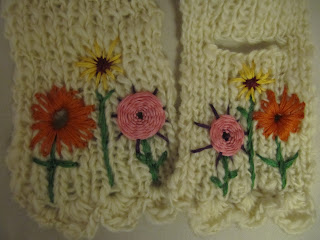Hallo to my darling embroidery students. I know that we have all been very busy, and I am still waiting for some of you to get your photos into me. Holly is the only one who got her piece into me on time and so this will make her the winner of this section, (makes it easy on the judging). Well done Holly, and I love what you did. All the others need to email their photographs into me so that I can put them all on a post, and then I will send their free sample packs to them for the next project.
I also need to know what it is that you are aspiring towards making cos there are so may ways that we could go. We could combine fabric painting embroidery, applique and ribbon work to make crazy doilies like the one above.
Or do you want to embroider masterpieces that you can frame and hang on the wall.
Or do you want to embroider onto clothing, for this one you will need to be able to sew or have a piece of clothing that you can sew onto or an embroidered piece of fabric that you can sew onto your piece of clothing. The really important thing about this is that you are bringing your art out into the street, and lets start thinking about our embroidery as our art, so put some thought into it, cos remember art is about ideas.
I cannot download all images onto my bog where I am at the moment, which is totally frustrating, but if you go to this post (see link below) and scroll down a bit, you will see some fabulous Art Nouveau embroidery patterns that would be a total work of art and look great in a frame. We could practice the satin stitch used to create these.
Or do you want to embroider onto clothing, for this one you will need to be able to sew or have a piece of clothing that you can sew onto or an embroidered piece of fabric that you can sew onto your piece of clothing. The really important thing about this is that you are bringing your art out into the street, and lets start thinking about our embroidery as our art, so put some thought into it, cos remember art is about ideas.
Or would you like to make a fabric covered box to keep you embroidery tools and threads etc. in it
You could embroider the top and make little loops etc to hold your tools,or maybe make-up inside.
Anyway let me know which way you want to go and I will suggest some stitches we could practice.
Isabel what would you like to do next, a picture to frame, or a bag, a box to keep things in, a cushion to embroider? Let me know.
Well I am going to have a wee sleep now so see you soon
xx
Anyway let me know which way you want to go and I will suggest some stitches we could practice.
Isabel what would you like to do next, a picture to frame, or a bag, a box to keep things in, a cushion to embroider? Let me know.
Well I am going to have a wee sleep now so see you soon
xx
















































